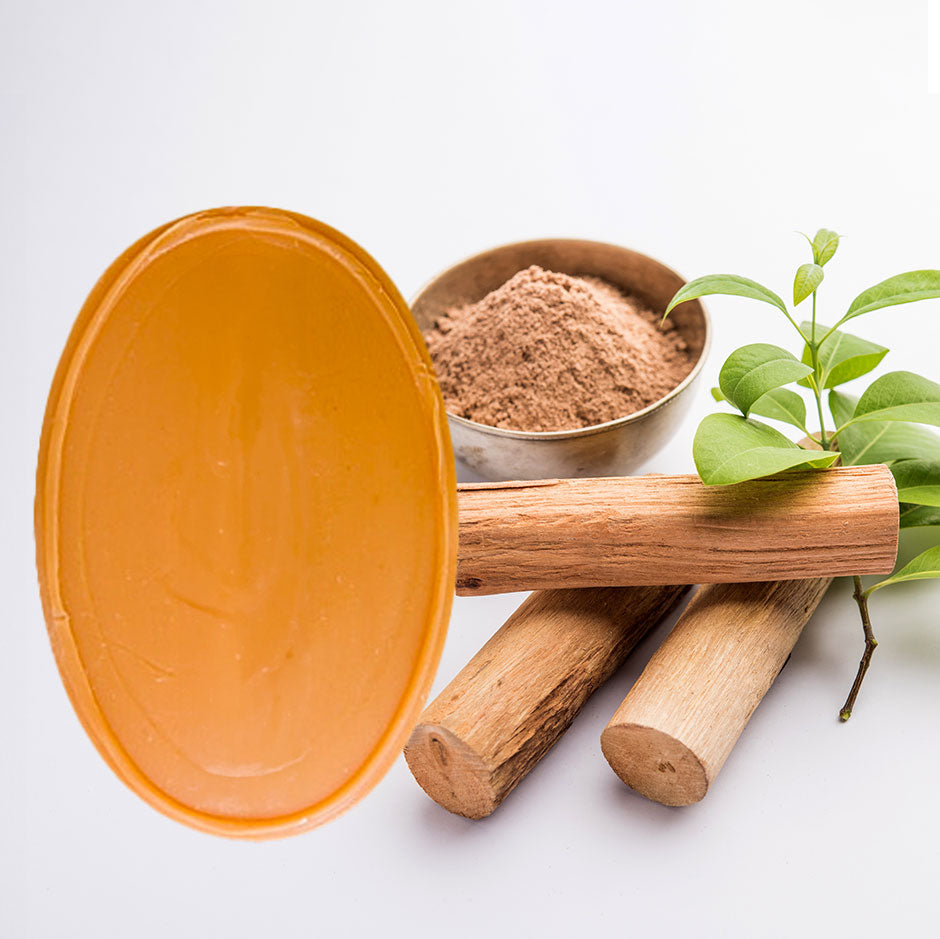Welcome to the journey of unraveling the charm and mystery of one of the oldest beauty secrets - sandalwood soap. In this article, we will embark on a fascinating exploration of the history, benefits, and the science behind the alluring fragrance of sandalwood soap. We'll also cover how to choose the right sandalwood soap, and how to incorporate it into your modern beauty regimen. And finally, we'll take a look at the importance of sustainability in the world of sandalwood.
The Everlasting Charm of Sandalwood
Sandalwood, with its intoxicating aroma, has been captivating hearts for centuries. But what is it about this aromatic wood that has made it so enduringly popular?
- A trip down memory lane: The historical backdrop of sandalwood
- The sacred connection: Sandalwood in ancient cultures
- Global travels: The journey of sandalwood across continents
- The birth of sandalwood soap: A luxurious addition to daily rituals
- The science behind the scent: Why sandalwood?
'Sandalwood is much more than just a fragrant wood. It's a symbol of tradition, a part of religious rituals, a staple in skincare, and a scent that can transport you to another time and place. The magic of sandalwood lies in its versatility and timeless appeal.'
The story of sandalwood begins thousands of years ago. It has been mentioned in ancient Sanskrit and Chinese manuscripts as a precious and sacred material. Sandalwood's deep, woody, and sweet-smelling aroma has made it a favorite for religious rituals, meditation, and skincare.
In ancient cultures, sandalwood was often associated with the divine. It was used in various religious ceremonies and rituals due to its ability to calm the mind and aid in meditation. From the ancient temples of India to the royal courts of China, sandalwood has left its mark everywhere.
Trade routes played a critical role in the spread of sandalwood across the world. Traders, travelers, and explorers carried sandalwood along the Silk Road, introducing it to different cultures and regions. This led to the global popularity of sandalwood, and it became a highly sought-after commodity.
The birth of sandalwood soap is a testament to the luxurious and indulgent nature of this aromatic wood. It was a way to incorporate the divine and calming properties of sandalwood into a daily ritual - bathing. The first sandalwood soaps were likely simple, handmade bars created using ancient recipes.
The allure of sandalwood lies not just in its mesmerizing aroma, but also in its therapeutic properties. Sandalwood oil, extracted from the wood, has been used in traditional medicine for its antiseptic, anti-inflammatory, and soothing properties. The unique composition of sandalwood oil, rich in sesquiterpenes, gives it a distinctive, long-lasting fragrance that has a calming effect on the senses.
Unraveling the Benefits of Sandalwood Soap
- A natural moisturizer: No more dry skin
- Anti-inflammatory magic: Relief for irritated skin
- Anti-aging marvel: Fighting off wrinkles
- A sensory delight: The soothing aroma
Sandalwood soap does wonders for the skin. It's a natural moisturizer, helping to keep your skin hydrated and supple. It's especially beneficial for those with dry skin. And it's not just about moisturization. Sandalwood soap also has anti-inflammatory properties, making it a great choice for soothing irritated skin.
One of the lesser-known benefits of sandalwood soap is its potential anti-aging effects. Sandalwood oil, a key ingredient in sandalwood soap, is rich in antioxidants that help fight off free radicals - the culprits behind premature aging and wrinkles. Regular use of sandalwood soap can help keep your skin looking youthful and radiant.
Beyond its skincare benefits, sandalwood soap is a treat for the senses. The warm, woody aroma of sandalwood can help to calm the mind and relieve stress. It's like having a mini spa experience right in your own bathroom.
The Role of Sandalwood Soap in Ancient Beauty Rituals
- Royal baths: A touch of luxury
- The beauty secrets of queens and princesses
- Sandalwood in traditional spa treatments
The use of sandalwood in beauty rituals dates back to ancient times. The royal baths were often scented with sandalwood, adding a touch of luxury and relaxation. It's said that queens and princesses used sandalwood oil for its skin-enhancing properties.
Sandalwood also found its way into traditional spa treatments. It was used in massage oils, face masks, and scrubs for its soothing and skin-nourishing benefits. Whether in the royal courts or in the homes of the common folk, sandalwood has always been a part of beauty and wellness routines.
Crafting Sandalwood Soap: A Sneak Peek
- Traditional techniques: Made with love and care
- Modern adaptations: How today's soap makers are innovating
Sandalwood soap has been traditionally handcrafted, with careful attention given to preserving the natural properties of sandalwood. The process involves blending sandalwood oil with other natural ingredients like plant oils and butters to create a soap that's gentle on the skin and rich in aroma.
But as with all things, sandalwood soap making has evolved with time. Today's artisans are innovating by combining traditional techniques with modern science. They're experimenting with different blends, adding other natural ingredients like essential oils and botanical extracts to enhance the benefits of sandalwood soap.
Selecting the Perfect Sandalwood Soap
- Identifying genuine sandalwood: What to look for
- The ideal mix: Pairing sandalwood with other ingredients
Choosing the right sandalwood soap can be a bit tricky, especially with so many options available in the market. One important tip is to look for soaps that list 'sandalwood oil' or 'sandalwood extract' as one of the main ingredients. Genuine sandalwood has a rich, warm, and long-lasting aroma. If the scent is faint or disappears quickly, it's likely not genuine sandalwood.
Another thing to consider is the blend of ingredients. Sandalwood pairs well with many other natural ingredients like rose, lavender, ylang-ylang, and citrus oils. These blends not only enhance the aroma but also add to the skincare benefits of the soap.
Incorporating Sandalwood Soap into Modern Beauty Regimes
- Making sandalwood soap a part of your daily routine
- DIY beauty treatments with sandalwood soap
Incorporating sandalwood soap into your daily routine can be as simple as replacing your regular soap or body wash with a sandalwood soap bar. Not only will you enjoy the therapeutic aroma during your bath, but your skin will also benefit from its moisturizing and soothing properties.
For those who love DIY beauty treatments, sandalwood soap can be a great addition to your recipes. You can use it to make a gentle face scrub, or melt it down to mix with other ingredients for a nourishing body wrap or mask.
Sustainability and Sandalwood: A Crucial Connection
- Concerns over sandalwood tree deforestation
- Supporting sustainable sandalwood farming
Sandalwood, once abundant in the South Indian states like Karnataka, has seen a sharp decline in its reserves. This decline is largely due to the absence of a sustained sandalwood regeneration program. The irony is palpable in a region that once had factories established to utilize its excess sandalwood reserves. This situation has led to a significant decrease in the production of the popular Mysore Sandal Soap.
The need for sustainable sandalwood farming is more evident now than ever before. By implementing sustainable farming practices, we can ensure that sandalwood, a vital resource, is not depleted. This would involve strategies like planting more sandalwood trees than are harvested and ensuring the health and well-being of these trees throughout their growth cycle.
Moreover, sustainable sandalwood farming is not just about preserving the resource for soap production. Sandalwood has a long-standing cultural and historic significance in India. It is used in various religious ceremonies and traditional medicine. Therefore, preserving sandalwood is also about preserving a part of India's rich cultural heritage.
In addition, sustainable sandalwood farming could also provide a stable income for farmers and help boost the rural economy. This, in turn, could lead to better living conditions and improved livelihoods for the farming communities.
Embracing the Legacy of Sandalwood Soap
As we wrap up our journey, it's evident that sandalwood soap is more than just a beauty product. It's a legacy, a testament to the timeless beauty rituals that have been passed down through generations.
The rich tapestry of its history, intertwined with tales of royalty, traders, and artisans, makes sandalwood soap a unique blend of culture, tradition, and nature.
In today's fast-paced world, where synthetic products often take precedence, the natural allure of sandalwood soap remains undiminished. Its therapeutic aroma, combined with its myriad skin benefits, makes it a cherished beauty elixir.
As we continue to explore and innovate in the realm of beauty and skincare, let's not forget the ancient wisdom that sandalwood brings to the table. By choosing genuine sandalwood products and supporting sustainable practices, we not only ensure the well-being of our skin but also contribute to preserving a rich heritage.
So, the next time you hold a bar of sandalwood soap in your hands, take a moment to appreciate its rich history, the ancient wisdom it carries, and the promise of radiant, healthy skin. Here's to rediscovering and celebrating the ancient beauty elixir - sandalwood soap!

